 W
WThe Kingdom of Kandy was an independent monarchy of the island of Sri Lanka, located in the central and eastern portion of the island. It was founded in the late 15th century and endured until the early 19th century.
 W
WAn Historical Relation of the Island Ceylon together With somewhat Concerning Severall Remarkable passages of my life that hath hapned since my Deliverance out of Captivity is a book written by the English trader and sailor Robert Knox in 1681. It describes his experiences some years earlier in the Kingdom of Kandy, on the island today known as Sri Lanka. It provides one of the most important contemporary accounts of 17th century Sri Lankan life.
 W
WAppuhamy or Appuhami from Appoe (Gentleman) and Hamie (Lord) is a Sinhala surname or an honorific term for men used traditionally between 14th and 20th centuries in Sri Lanka (Ceylon). It is also a term used for Dugaganna Rala of Kandyan era kings.
 W
WBalana Fort was built by the Kingdom of Kandy near Alagalla Mountain Range, Sri Lanka. It was a strategic rock fortress and an outpost for the kingdom. When the English established themselves in Kandy, colonizers raised tea and coffee plantations near the Colombo-Kandy railway line.
 W
WBatticaloa is a major city in the Eastern Province, Sri Lanka, and its former capital. It is the administrative capital of the Batticaloa District. The city is the seat of the Eastern University of Sri Lanka and is a major commercial city. It is on the east coast, 111 kilometres (69 mi) south of Trincomalee, and is situated on an island. Pasikudah is popular tourist destinations situated 35 km northwest with beaches and flat year-round warm-water shallow-lagoons.
 W
WThe Battle of Gannoruwa was a battle of the Sinhalese–Portuguese War fought in 1638 between the occupying Portuguese forces and the Sinhalese King's army at Gannoruwa in the District of Kandy, Sri Lanka. The Portuguese had attempted three times without success to capture the Kingdom of Kandy, in order to bring the entire island under their rule. In 1635, Rajasinghe II became the king of Kandy and started negotiations with the Dutch to obtain their help in driving out the Portuguese. The Portuguese hastened their efforts to take Kandy because of this, and Diogo de Melo de Castro, the Portuguese Captain General, tried to provoke the Sinhalese on several occasions.
 W
WThe Bogoda Wooden Bridge was built in the 16th century during the Dambadeniya era. This is said to be the oldest surviving wooden bridge in Sri Lanka. The bridge is situated at 7 kilometres (4.3 mi) west of Badulla. All parts of this bridge were constructed from wood, including the use of wooden nails as fixing material. The roof tiles show the influence of Kingdom of Kandy. The bridge was built across the Gallanda Oya, which linked Badulla and Kandy on an ancient route.
 W
WThe Central Province is one of the nine provinces of Sri Lanka, the first level administrative division of the country. The Central Province is primarily in the central mountainous terrain of Sri Lanka. It is the 6th largest province by area and is home to 2.5 million people. It is bordered by North Central Province to the north, Uva Province to the east, North Western Province to the west and Sabaragamuwa Province to the south and west. The province's capital is Kandy.
 W
WDivurum Bodhi Viharaya is a Theravada Buddhist temple in the Kandy District, Sri Lanka. It is located on Ampitiya Road, Ampitiya.
 W
WDiyawadana Nilame is the office of the chief lay custodian of Temple of the Tooth, Kandy, Sri Lanka. Formerly an office of the royal household, at present it is the trustee for the Temple of the Tooth as defined by the Buddhist Temporalities Ordinance of 1931. A ceremonial position, enriched with over two thousand years of history to safeguard and carry out ancient rituals for the relic of the tooth of the Buddha. The Diyawadana Nilame has the responsibility of overseeing of all aspects of the Sri Dalada Maligawa. He has the traditional duty of organizing the annual pageant, the Kandy Esala Perahera. The current Diyawadana Nilame is Pradeep Nilanga Dela.
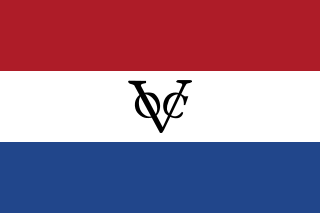 W
WDutch Ceylon was a governorate established in present-day Sri Lanka by the Dutch East India Company. Although the Dutch managed to capture most of the coastal areas in Sri Lanka they were never able to control the Kandyan Kingdom located in the interior of the island. Dutch Ceylon existed from 1640 until 1796.
 W
WThe Dutch–Portuguese War was an armed conflict involving Dutch forces, in the form of the Dutch East India Company and the Dutch West India Company, against the Portuguese Empire. Beginning in 1602, the conflict primarily involved the Dutch companies invading Portuguese colonies in the Americas, Africa, India and the Far East. The war can be thought of as an extension of the Eighty Years' War being fought in Europe at the time between Spain and the Netherlands, as Portugal was in a dynastic union with the Spanish Crown after the War of the Portuguese Succession, for most of the conflict. However, the conflict had little to do with the war in Europe and served mainly as a way for the Dutch to gain an overseas empire and control trade at the cost of the Portuguese. English forces also assisted the Dutch at certain points in the war. Because of the commodity at the center of the conflict, this war would be nicknamed the Spice War.
 W
WThe Uwa Wellassa Great Rebellion of 1817–1818 ඌව වෙල්ලස්ස මහ කැරැල්ල , also known as the 1818 Uva–Wellassa uprising, or simply the Uva rebellion, was the third Kandyan War with the British, in what is now Sri Lanka. It took place in what is now Uva, which was then a province of the Kingdom of Kandy, against the British colonial government under Governor Robert Brownrigg, which had been controlling the formerly independent Udarata.
 W
WIndependence Memorial Hall is a national monument in Sri Lanka built for commemoration of the independence of Sri Lanka from the British rule with the restoration of full governing responsibility to a Ceylonese-elected legislature on February 4, 1948. It is located in Independence Square in the Cinnamon Gardens, Colombo. It also houses the Independence Memorial Museum.
 W
WKandy is a major city in Sri Lanka located in the Central Province. It was the last capital of the ancient kings' era of Sri Lanka. The city lies in the midst of hills in the Kandy plateau, which crosses an area of tropical plantations, mainly tea. Kandy is both an administrative and religious city and is also the capital of the Central Province. Kandy is the home of the Temple of the Tooth Relic, one of the most sacred places of worship in the Buddhist world. It was declared a world heritage site by UNESCO in 1988. Historically the local Buddhist rulers resisted Portuguese, Dutch, and British colonial expansion and occupation.
 W
WKandy District is a district of the Central Province of Sri Lanka. Its area is 1906.3 km². The capital of the district is Kandy.
 W
WKandy Lake, also known as Kiri Muhuda or the Sea of Milk, is an artificial lake in the heart of the hill city of Kandy, Sri Lanka, built in 1807 by King Sri Wickrama Rajasinghe next to the Temple of the Tooth. Over the years, it was reduced in size. It is a protected lake, with fishing banned.
 W
WKandyan jewellery comes from the hill capital of Ceylon or Sri Lanka. The Kandyan Kingdom lasted till 1815 resulting in the original sets of jewellery and designs still being preserved and worn by Kandyan families today.
 W
WKandyan era frescoes are mural paintings created during the Kingdom of Kandy (1469–1815) in Sri Lanka, a time when kings gave a special place to arts and literature.
 W
WThe Kandyan Wars refers generally to the period of warfare between the British colonial forces and the Kingdom of Kandy, on the island of what is now Sri Lanka, between 1796 and 1818. More specifically it is used to describe the expeditionary campaigns of the British Army in the Kingdom of Kandy in 1803 and 1815.
 W
WThe Kandyan monarchs ruled the Kingdom of Kandy from 1469 to 1815. The Kingdom was first established by Senasammata Vikramabahu, a royal from the Kingdom of Kotte, when he led the secession of the Kande uda pas rata, a realm of the Kingdom of Kotte, during the reign of Parakramabahu VI. Vikramabahu, who founded the city of Kandy reigned for 4 decades, setting an example of longevity and stability for the new kingdom. It is possible to say that the Kingdom of Kandy was ruled by three dynasties, the House of Siri Sanga Bo, the House of Dinajara and the Nayaks of Kandy.
 W
WThe Mahâ Adigâr was a Great Officer in the Amātya Mandalaya, or Sinhalese Council of State, in the Sinhalese Kingdoms of premodern Sri Lanka. The office was second in power and dignity to the King. Like many of the existing high offices at the time it had combined legislative and judicial powers and functioned primarily equivalent to that of a Prime Minister and Chief Justice, but also had duties in the government of a province. During the Kandyan period there were two Adigars, who were styled Mahâ Nilames, the Pallegampahê Mahâ Nilamê and the Udagampahê Mahâ Nilamê, the former taking precedence over the latter.
 W
WThe Mahâ Dissâvas was a Great Officer in the Amātya Mandalaya, or Sinhalese Council of State, in the Sinhalese Kingdoms of premodern Sri Lanka. Like many of the existing high offices at the time it had combined legislative and judicial powers and functioned primarily equivalent to that of a Provincial governor. The office of Dissava was retained under the successive European colonial powers, namely the Portuguese Empire, the Dutch East India Company and the British Empire. A Dissava was the governor a province known as a Disavanies. With his province, the Dissava held both executive and judicial authority.
 W
WMatale often written as Mathalai is a large regional city located at the heart of the Central Hills of the island lies in a broad, fertile valley at an elevation of 364 m (1,194 ft) above sea level. It is the administrative capital and largest city of Matale District, Central Province, Sri Lanka. It is 142 kilometres (88 mi) from Colombo and near Kandy. Surrounding the city are the Knuckles Mountain Range, the foothills were called Wiltshire by the British.
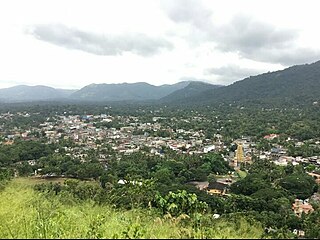 W
WMatale District is a district in Central Province, Sri Lanka. It is one of 25 districts of Sri Lanka, the second level administrative division of the country. The district is administered by a District Secretariat headed by a District Secretary appointed by the central government of Sri Lanka. The administrative capital and largest city of the district is Matale.
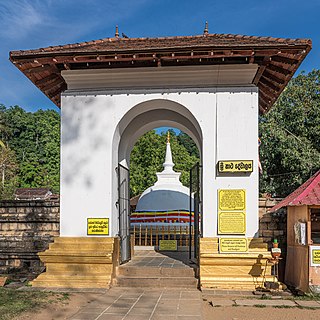 W
WThe Nàtha Devàla is located on the terrace, in front of the Royal Palace complex in Kandy. It is said to have been in existence even before the Tooth Relic was brought to Kandy. The oldest extant structure in Kandy, it is said to have been built by King Vikramabahu III in the 14th century. The history of the worship of God Natha is not clear. The name 'Natha' literally means ‘no form’ and ‘no shape’, and is therefore generally associated with Lord Maitreya, the next Buddha.
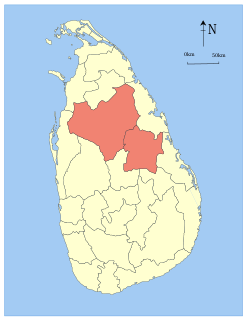 W
WNorth Central Province is one of the nine provinces of Sri Lanka, the first level administrative division of the country. The provinces have existed since the 19th century but did not have any legal status until 1987 when the 13th Amendment to the Constitution of Sri Lanka established provincial councils. The province is the largest by size, and second least populated in the country. The province consists of the districts of Anuradhapura and Polonnaruwa, both of which were important ancient Sri Lankan kingdoms. The climate is semi-arid, and the forests are dry evergreen forests.
 W
WNuwara Eliya District is a district in Central Province, Sri Lanka, centered on the tourist city of Nuwara Eliya.
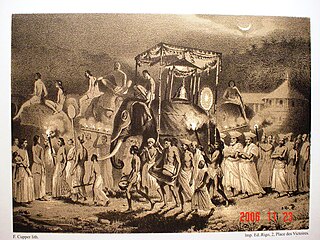 W
WRadala refers to a small minority caste in the Kandyan Kingdom of Sri Lanka. They were the Chiefs of the Kingdom of Kandy. The term Radala is coming from the combination of words Radh and Kola or Kula, which literally means the royal caste. The word "Radala" came into existence after the throne of the Kingdom of Kandy went to the Nayak Dynasty. Higher officials in the court of Vira Narendra Sinha were offered this state and Nayakkara prince was selected as king over king's son by a local queen. After capturing the Kandyan provinces in 1815 with the aid of locals from both maritime and Kandyan provinces, the British created an extensive class of loyal 'New Radalas' in the Kandyan territory to assist them in the administration of that province.
 W
WRate Mahatmaya was a traditional office and title from the Kandian Kingdom which became part of the British colonial administration within the Kandian and central region of Ceylon.
 W
WThe Royal Palace of Kandy, located to the north of the Temple of the Tooth in Kandy, was the royal residence of the Sri Lankan monarchy of the Kingdom of Kandy in Sri Lanka. The last king to reside in it was King Sri Vikrama Rajasinha (1798–1815). Once part of a large palace complex that included the King's Palace, Royal Audience Hall, Queen's Palace, King's Harem Quarters and Queen's Bathing Pavilion (Ulpange), together with the Temple of the Tooth. Adjacent to the Royal Palace is the Victorian era building that until recently housed Kandy High Court.
 W
WThe Sabaragamuwa Province is one of the nine provinces of Sri Lanka, the first level administrative division of the country. The provinces have existed since the 19th century but did not have any legal status until 1987 when the 13th Amendment to the Constitution of Sri Lanka established provincial councils. The Sabaragamuwa Province contains two districts: Ratnapura and Kegalle. It is named after its former indigenous inhabitants, namely the Sabara, an indic term for hunter-gatherer tribes, a term seldom used in ancient Sri Lanka. Sabaragamuwa University is in Belihuloya.
 W
WThe Sinhalese–Portuguese War was a series of conflicts waged from 1527 to 1658 during the Transitional and Kandyan periods in Sri Lanka between the Sinhalese kingdoms and their allies, against the Portuguese Empire. The Crisis of the Sixteenth Century (1521–1597), started with the Vijayabā Kollaya, the division of the Sinhala Kingdom, then centered at Kotte. The country was divided among three brothers resulting in a series of Wars of Succession. It was also at this time that the Portuguese, whose arrival in Sri Lanka was largely accidental, intruded into the internal affairs of Sri Lanka, establishing control over the maritime regions of the island and sought to control its lucrative external trade.
 W
WSri Lankan Malays, also known in Sinhalese as Ja Minissu, are Sri Lankans with full or partial ancestry from the Indonesian/Malay Archipelago. The term is a misnomer as it is used as a historical catch-all term for all native ethnic groups of the Malay Archipelago who reside in Sri Lanka; the term does not apply solely to the ethnic Malays. They number approximately 40,000 and make up 0.2% of the Sri Lankan population, making them the fourth largest of the five main ethnic groups in the country.
 W
WSri Maha Bodhi Viharaya is a Theravada Buddhist temple in Kandy, Sri Lanka. It is located in Bahirawakanda, approximately 2 km (1.2 mi) from the city centre. The temple is known for its giant Buddha statue. The statue of Buddha is depicted in the position of the Dhyana Mudra, the posture of meditation associated with his first Enlightenment, and can be seen from almost everywhere in Kandy. It stands at 26.83 m (88.0 ft) high and is one of the tallest Buddha statues in Sri Lanka.
 W
WSri Dalada Maligawa or the Temple of the Sacred Tooth Relic is a Buddhist temple in the city of Kandy, Sri Lanka. It is located in the royal palace complex of the former Kingdom of Kandy, which houses the relic of the tooth of the Buddha. Since ancient times, the relic has played an important role in local politics because it is believed that whoever holds the relic holds the governance of the country. Kandy was the last capital of the Sri Lankan kings and is a World Heritage Site mainly due to the temple.
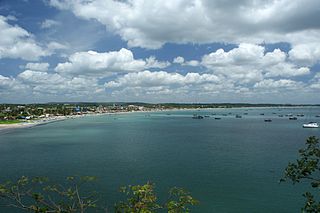 W
WTrincomalee also known as Gokanna/Gokarna, is the administrative headquarters of the Trincomalee District and major resort port city of Eastern Province, Sri Lanka. Located on the east coast of the island overlooking the Trincomalee Harbour, 237 kilometres (147 mi) north-east of Colombo, 182 kilometres (113 mi) south-east of Jaffna and 111 kilometres (69 mi) miles north of Batticaloa, Trincomalee has been one of the main centres of Sri Lankan Tamil language speaking culture on the island for over two millennia. With a population of 99,135, the city is built on a peninsula of the same name, which divides its inner and outer harbours. People from Trincomalee are known as Trincomalians and the local authority is Trincomalee Urban Council. Trincomalee city is home to the famous Koneswaram temple from where it developed and earned its historic Tamil name Thirukonamalai. The town is home to other historical monuments such as the Bhadrakali Amman Temple, Trincomalee, the Trincomalee Hindu Cultural Hall and, opened in 1897, the Trincomalee Hindu College. Trincomalee is also the site of the Trincomalee railway station and an ancient ferry service to Jaffna and the south side of the harbour at Muttur.
 W
WWalauwa or walawwa is the name given to a feudal/colonial manor house in Sri Lanka of a native headmen. It is also refers to the feudal social systems that existed during the colonial era.